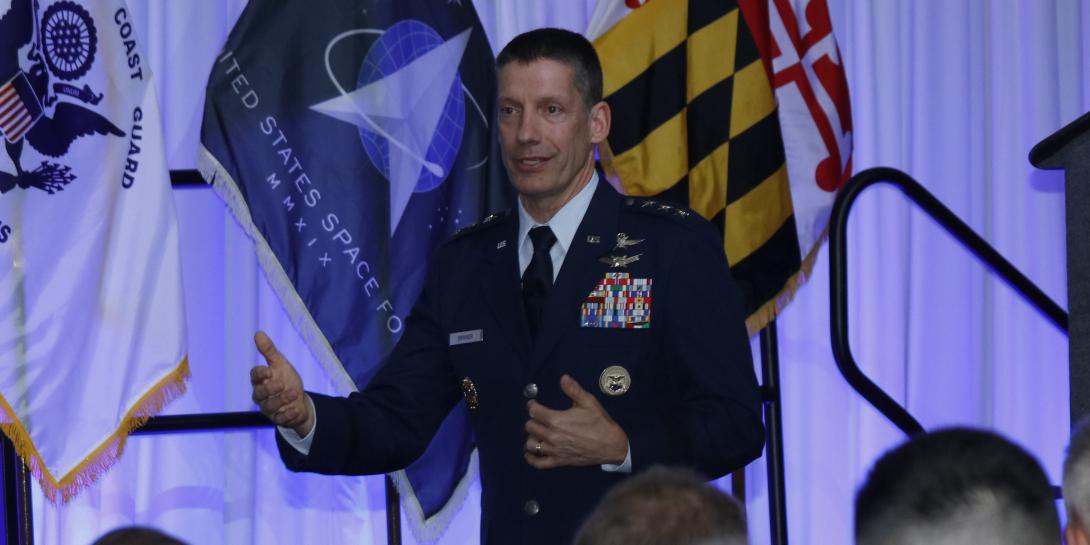DISA’s Dream List of Digital Solutions
The need to address solution gaps has the attention of the director of the Defense Information Systems Agency (DISA). The agency’s leader, Lt. Gen. Robert Skinner, USAF, who is also commander of the Joint Force Headquarters-Department of Defense Information Network, has spent the last year reorganizing, setting strategic goals and identifying key lines of effort. Next up is tackling a wish list of nagging gaps or areas in which technology is negatively impacting warfighter operations, and Gen. Skinner is calling on warfighters and industry to assist with innovative solutions.
“Every great innovation started out in some form or fashion with somebody saying, ‘Wouldn’t it be great if,’” Gen. Skinner said. “And in looking at [what we should focus on] over the next year, I got to thinking, ‘Wouldn't it be cool if’..., and how do we answer that question.”
From an ICAM perspective, it has to be for a federated environment says Lt. Gen. Skinner @USDISA #AFCEACyber pic.twitter.com/fxreg3LBCH
— Kimberly Underwood (@Kunderwood_SGNL) April 26, 2022
The director identified ideas, desired technologies, solutions or outcomes that would improve DISA’s mission support and advance warfighter operations.
“Here's about 14 ideas and thoughts that can generate discussion of things that we are looking at as an agency and as the Joint Force Headquarters to get after the mission as a combat sport agency and as an operational-level C2 [command and control] headquarters to really push us further into the future,” Lt. Gen. Skinner emphasized.
He said, “Wouldn’t it be cool if, we:”
- Were able to deploy cloud environments in hours;
- Had a true single sign-on into network environments;
- Offered legacy and new development security operations (DevSecOps) pipelines;
- Had a mobile force with multilevel security;
- Saw innovative solutions from industry that actually scale to meet DISA and DoD needs;
- Had the ability to optimize current capabilities;
- Gave users their IT devices and login information, and had no step 3;
- Had seamless network transport;
- Had consistent software licensing;
- Offered endpoint performance that "didn’t crush souls;”
- Had risk management framework environments that were operational and continuous;
- Had easy battlespace visualization solutions;
- Could deliver minimum viable products in months; and
- Mastered workforce empowerment.
Gen. Skinner cited last summer’s evacuation of Afghanistan as an example that brought to light an urgent need for improvements to infrastructure as code and cloud capabilities.
“During Operation Afghan Refuge, AMC [Air Mobility Command] and TRANSCOM [the Transportation Command] had so many flights going in and out [of Afghanistan] and being able to track those with modern technology and leveraging the cloud was difficult,” the director said. “They came to DISA and said, ‘Can you help?’ and within 72 hours [we stood] up a cloud instantiation, got the application working and they were actually able to track all the planes that were that were coming in and out [of Hamid Karzai International Airport]. It was a huge win in our perspective. And some may say, ‘Well, we can do that in minutes,’ but the ability to do that with the application, the command and control, and everything else, and doing that in 72 hours versus weeks or months, that was a significant change.”
Going forward, DISA wants to identify and improve how the agency “will really leverage cloud and cloud capabilities to support our warfighter,” Gen. Skinner added.
Another area for improvement involves user log-in abilities to operate in a joint all domain operational environment, one that involves allies and partners.
“At the end of the day, what we really need is a joint and coalition environment,” the director noted. “We have a mission partner environment. We have JADC2 [Joint All Domain Command and Control] and how do we bring all of those together to truly have [a single sign-on], so that when any individual logs in to whatever their logging into, they have the right permissions, the right accesses to the right systems and the right data to perform their mission, no matter where they're logging in from and no matter what device their logging into, as long as they have the credentials. We do not have that today. And bringing all that together from a joint standpoint is really where I think we could leverage industries’ help.”
DISA also would like to be able to apply a DevSecOps software environment to its legacy systems, Gen. Skinner continued. “DevSecOps is pretty cool if you have a modern application and you're leveraging modern languages and modern technology,” he said. “But what about legacy? How do we truly bring DevSecOps to the legacy environment? That's hard. We could use your help there.”
Moreover, Director Skinner instructed industry to address the needed considerations of size, scope, importance and urgency when offering any technology solutions to the agency. DISA manages infrastructure in 42 countries and serves the President, the Joint Chiefs of Staff, the U.S. combatant commanders and a multitude of mission partners across the Department of Defense.
To industry: Never forget the size and scale when presenting solutions to @USDISA - we have over 4 million users, advises Lt. Gen. Robert Skinner #AFCEACyber pic.twitter.com/8q6VFTlCnO
— Kimberly Underwood (@Kunderwood_SGNL) April 26, 2022
“I don’t know how many companies will come and say, ‘I have the perfect solution, I have the perfect tool for what you are trying to do,” he stressed. “And then when you get through their slides, the marketing brochures and we start talking about scalability [then it’s problem]. We have over 300 million IP [Internet protocol] addresses in the Department of Defense. That is more than any country in the world but two. We have 4 million users, 15,000 different networks. We could go on and on about the scale and complexity of our environment.
“Keep that in mind as you're talking with our team,” Gen. Skinner advised.




Comments